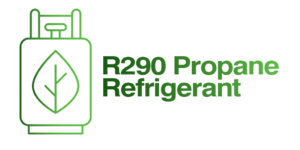The Rise of Propane in Modern HVAC Heat Pump Systems
 In a world that demands more sustainable and energy-efficient solutions, it is becoming increasingly obvious that the decarbonisation of buildings in the UK has a key part to play when it comes to achieving the target of net zero greenhouse gas emissions by 2050.
In a world that demands more sustainable and energy-efficient solutions, it is becoming increasingly obvious that the decarbonisation of buildings in the UK has a key part to play when it comes to achieving the target of net zero greenhouse gas emissions by 2050.
As an industry, HVAC is constantly looking to adopt the latest technologies to meet these demands and in the innovative world of critical cooling solutions the spotlight is beginning to focus on Propane (R290). The use of propane in modern heat pump systems presents an exciting new opportunity in the HVAC industry, and in this article we’re exploring the benefits, applications, and considerations of using propane chillers to offer professional insight into what changing to propane means to a commercial or industrial building.
Old for New?
When replacing a boiler with a propane heat pump system there are several considerations and steps to digest, and whilst a one-to-one replacement is not straightforward, with proper planning and execution it is possible. If we consider the overall life cycle, financial and environmental benefits of such a change, in my experience, they usually far outweigh any inconvenience or upfront capital cost.
Key Points to Consider
Traditionally reversible heat pumps have often struggled to achieve the high water temperatures that commercial boilers typically operate at (70°C to 85°C) and, as such they have often relied upon the addition of electric boost heating or cascade systems to increase water production temperatures from 50 – 60°C, both using refrigerants such as R410a and R32 in the most favourable conditions possible!
By deploying the additional electric boost heating to accommodate peak winter demands, or alternatively, a cascade heat pump arrangement, higher temperatures could be achieved by using one heat pump to preheat the water and another to further increase the temperature output.
When considering the pros and cons of deploying a more energy-efficient and sustainable heating solution, these workarounds often added unnecessary complexity that wasn’t previously needed or taken into consideration when using traditional fossil fuel boilers. Combined with the impact of the additional plant space required, the introduction of new system controls, and increased costs on both installation and capital plant they have often been perceived as a negative for the end user when considering the implications of swapping a boiler out for a heat pump alternative as a whole.
Is There an Easier Way?
With recent advancements in technology and low GWP refrigerants such as Propane and CO2, HVAC can now offer a very compelling solution to these challenges by demonstrating the ability to achieve the desired water temperatures directly from the source at 75°C without the need for additional electric boost heating or cascade systems. This simplifies the system design and the installation process, as well as reducing both cost and time for the end user – making the transition to a more sustainable, highly efficient, and cost-effective solution.
Considerations When Using Propane
Traditionally used as a fuel for heating, cooking, and in some industrial processes, propane differs in chemical structure and properties from Polyfluoroalkyl Substances (PFAS), and as such it is not associated with the environmental and health concerns that PFAS pose.
As a natural refrigerant with a Global Warming Potential (GWP) of just three, and zero Ozone Depletion Potential (ODP), propane makes an environmentally friendly alternative to traditional refrigerants like R410A, which has a GWP of around 2088. In addition to the ultra-low GWP, propane is not subject to the same regulatory scrutiny as PFAS-containing substances due to it being a simple hydrocarbon, and does not contain the fluorinated compounds that characterize PFAS – making it a safer and more sustainable choice for HVAC systems.
By introducing propane as an alternative refrigerant the environmental and health risks associated with PFAS can be avoided, whilst providing a more sustainable and efficient cooling solution.
Improved Energy Efficiency
Propane reversible heat pump systems are known for their high energy efficiency. They can often achieve higher coefficient of performance (COP) and seasonal energy efficiency ratio (SEER) values compared to systems using older refrigerants. This means they use less energy to provide the same level of cooling or heating, leading to lower operating costs and reduced energy consumption.
Versatility and Applications
Modern propane cooling and heating systems are versatile across many applications, from residential and commercial to industrial operations and can efficiently produce hot water up to 75°C, even in very cold outdoor conditions.
With excellent thermodynamic properties, such as a high latent heat of vaporisation and a low boiling point, propane is suitable for a wide range of temperatures, noting that a temperature of 60°C is required for legionella purge of domestic hot water (DHW)propane can achieve these temperatures down to -10°C ambient.
Particularly well-suited for air conditioning and heat pump systems, propane systems provide hot water for everyday use with reliability, whilst ensuring efficiency and safety, with the added bonus of minimising energy consumption.
System Design
Modern propane heat pump systems are designed to optimise the refrigerant’s properties. This includes advanced compressor technology and heat exchanger designs that maximise the efficiency and heat transfer capabilities of propane.
An important aspect to consider for any system is the heat loads that the unit will be expected to run.
When peak heating loads (in winter) or peak cooling loads (in summer) dictate additional capacity requirements a two pipe reversible heat pump provides an economical solution.
A modular configuration allows for defrost periods and even better system part load efficiency.
At low operating temperatures, defrosting the heat pump heat exchanger is a necessary process in order to maintain system performance and efficiency. A quick and simple method involves reversing the function of the heat pump to take heat from the water circuit and reverse the function of the outdoor heat exchanger from evaporator to condenser. It’s important to retain enough hot water content to support temporary reverse cycle operation to defrost the outdoor unit heat exchanger.
With multiple heat pumps bolted together it is important to sequence the defrost cycle so that heating can still be delivered to the building during this process.
When designing a system it’s also important to consider that heat pumps all have a minimum water volume requirement, as well as the low operating temperatures. A buffer vessel will ensure that the heat pump runs for a minimum amount of time in order to reduce the number of times that the compressor will switch on and off, therefore reducing the wear and tear of the compressor. Using buffer vessels can be very beneficial as they can help to reduce any potential fluctuations in the supplied flow temperature.
Safety First
Ensuring safety when designing a propane heat pump system is vital in all situations, and there are very stringent standards in place to ensure proper ventilation, leak detection and positioning are all taken into consideration.
Due to being highly flammable, propane’s use in refrigeration systems is governed by strict safety standards, such as EN 378. Propane heat pump systems are required to have built in leak detection and ATEX approved fans. ATEX is the term commonly used for the two European directives for controlling explosive atmospheres, these are directives 99/92/EC and 2014/34/EU. The water circuit is required to have an automatic air purge system to release refrigerant and have a water pressure relief valve in the event of a water heat exchanger fault (Site Installed). These must be installed or ducted outside of the building away from potential ignition sources.
However, it’s important to note that because propane is highly flammable, it requires careful handling and adherence to strict safety protocols. Reputable suppliers of propane heat pumps should always issue guidelines with their products, and it is imperative that installation, maintenance, service and commissioning is always carried out by qualified class A3 refrigerant engineers.
Always check, never assume!
What about C02?
Another low GWP and 0 ODP refrigerant to consider for high temperature applications is CO2. As a sustainable option it too can provide the energy efficiency and DHW in the same way as propane, CO2 can only achieve a high coefficient of performance (COP) when utilising a high Delta T (temperature difference between flow and return temperatures). When looking at refurbishment projects for heating requiring high flow and return temperatures this is a huge draw back.
Conclusion
The adoption of propane in modern HVAC heat pump systems represents a significant step towards more sustainable and energy-efficient cooling and heating solutions. With environmental benefits, high performance, and cost-effectiveness, propane is poised to play a crucial role in the future of HVAC technology.
Visit our MultiChill™ Propane product page to learn more, or for more information please feel free to Contact Us.





